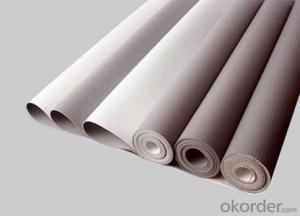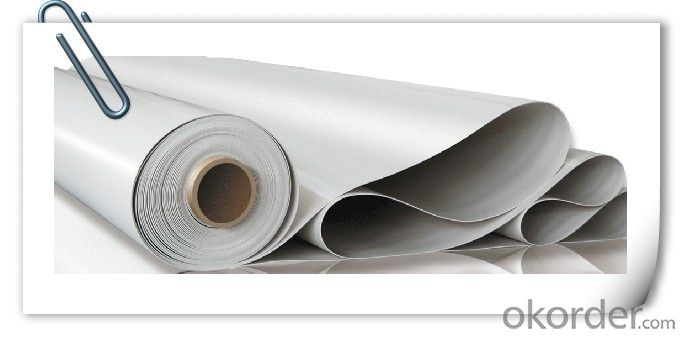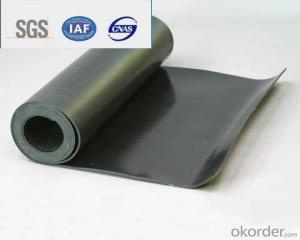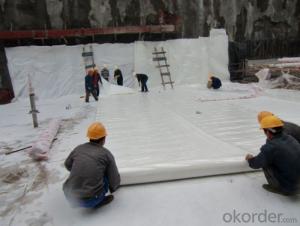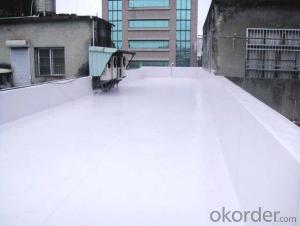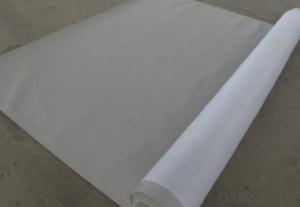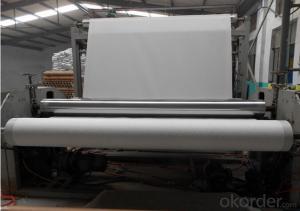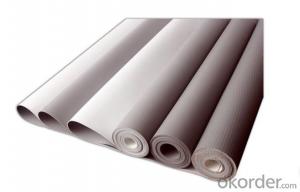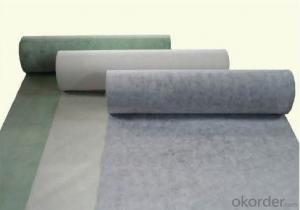Uniformity of polyvinyl chloride (PVC) waterproofing membrane
- Loading Port:
- China main port
- Payment Terms:
- TT OR LC
- Min Order Qty:
- 10000 m²
- Supply Capability:
- 300000 m²/month
OKorder Service Pledge
OKorder Financial Service
You Might Also Like
1.Structure of PVC Waterproofing Membrane Description:
Uniformity of polyvinyl chloride (PVC) waterproofing membrane is a kind of excellent high quality, high polymer waterproof material, PVC resin as the main raw material. The PVC resin and plasticizer, anti-uv agent, anti-aging agent, stabilizer, processing AIDS, molding of polymer waterproof coiled material is manufactured by extrusion method. The use of advanced equipment and advanced technology production made. This product with unique product formulations, waterproof materials, product life far beyond the general product has high tensile strength, elongation, shrinkage of small, low temperature flexibility and long life of the waterproof system, roof for more than 20 years, underground for more than 50 years, has been widely used in architecture, civil engineering, to adapt to the roofing construction ,underground engineering ,tunnel engineering and the application of special occasions, the product performance is stable, reliable quality, convenient construction.
2.Main Features of PVC Waterproofing Membrane:
Long service life, resistant to ageing
High tensile strength, elongation rate is high, the heat treatment small size change
Good root permeability resistance, good resistance to perforation
Construction is convenient, welding, firm and reliable environmental protection free from contamination
3.PVC Waterproofing Membrane Specification:
| Tensile Strength | ≥7.5 Mpa | |||
| Elongation at break | ≥450% | |||
| Tear strength | ≥25 KN/m | |||
Low temperature bending | ≤-40℃ | |||
4.PVC Waterproofing Membrane Images:
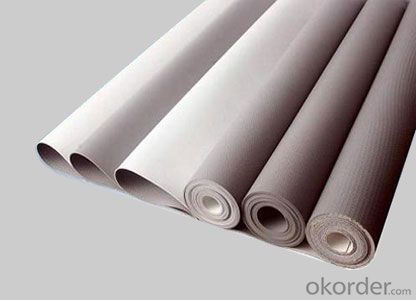
- Q: Does a waterproofing membrane require any special tools or equipment for installation?
- Typically, a waterproofing membrane installation would necessitate the use of specific tools and equipment. The presence of these tools and equipment is crucial in order to guarantee a proper and effective installation. Some commonly employed tools throughout the installation procedure include a trowel, roller, brush, and squeegee. These tools assist in the even and smooth application of the membrane. Moreover, particular types of waterproofing membranes that require heat activation might necessitate the use of specialized equipment like a heat gun or torch. It is of utmost importance to adhere to the manufacturer's instructions and guidelines regarding the tools and equipment required for the specific type of waterproofing membrane being utilized. By utilizing the appropriate tools and equipment, one can ensure a successful installation and enhance the performance and durability of the waterproofing membrane.
- Q: Are waterproofing membranes suitable for residential basements?
- Residential basements can indeed benefit from the use of waterproofing membranes. These membranes are specifically engineered to avert water infiltration and safeguard the basement against any harm caused by moisture. Whether applied on the interior or exterior walls, they create a formidable barrier against both water and dampness. This, in turn, helps to stave off problems like mold growth, water damage, and structural decay. With their excellent durability and ability to foster a dry and wholesome living space, waterproofing membranes emerge as a highly effective solution for residential basements.
- Q: Does a waterproofing membrane prevent water infiltration through concrete?
- Yes, a waterproofing membrane is designed to prevent water infiltration through concrete. It acts as a barrier, preventing water from seeping through the concrete and causing damage.
- Q: Are waterproofing membranes resistant to water vapor transmission?
- Waterproofing membranes possess a resistance to the transmission of water vapor. These membranes function to construct a barrier, effectively hindering water penetration. Typically composed of impermeable materials like rubber, plastic, or bitumen, they effectively obstruct the flow of liquid water, preventing its infiltration into the underlying structure. Nevertheless, it is worth noting that although waterproofing membranes can effectively resist the transmission of water vapor, it may not entirely eradicate it. A certain degree of water vapor may still manage to permeate the membrane, albeit significantly reduced in comparison to materials not specifically intended for waterproofing.
- Q: How does a waterproofing membrane adhere to the substrate?
- A waterproofing membrane adheres to the substrate through a combination of different mechanisms. The primary method is through the use of adhesives, which are specifically designed to bond the membrane to the surface. These adhesives can be either solvent-based or water-based, depending on the type of membrane and the substrate being used. Additionally, some waterproofing membranes have a self-adhesive backing, which eliminates the need for separate adhesive application. These membranes typically have a peel-off backing that exposes a sticky surface, allowing for easy installation onto the substrate. Another method of adhesion is through the use of mechanical fasteners. In this case, the membrane is secured to the substrate using screws, nails, or other similar fasteners. This method is commonly used in applications where the membrane needs to be attached to a rigid surface, such as concrete or metal. The choice of adhesive or fastening method depends on various factors, including the type of waterproofing membrane being used, the substrate material, and the specific application requirements. It is important to follow the manufacturer's instructions and guidelines to ensure proper adhesion and a long-lasting waterproofing solution.
- Q: Can a waterproofing membrane be used for a green roof system?
- Yes, a waterproofing membrane can be used for a green roof system. In fact, a high-quality waterproofing membrane is an essential component of a green roof system. Green roofs are designed to support the growth of vegetation and require a durable and reliable waterproofing barrier to prevent water leakage and protect the underlying structure from moisture damage. A waterproofing membrane acts as a protective layer, effectively sealing the roof and preventing water from penetrating into the building. Additionally, the membrane helps to retain water within the green roof system, ensuring that the plants receive an adequate water supply. Therefore, integrating a waterproofing membrane into a green roof system is crucial for its success and longevity.
- Q: Can a waterproofing membrane be used for underwater structures?
- Indeed, underwater structures can benefit from the utilization of a waterproofing membrane. These membranes have been specifically engineered to create a formidable barrier against water infiltration, rendering them appropriate for various applications, including underwater structures. Typically composed of robust materials like reinforced PVC or rubber, these membranes possess exceptional water resistance capabilities and effectively safeguard submerged surfaces by forming a reliable seal. Whether it be a swimming pool, underwater tunnel, or offshore platform, the implementation of a waterproofing membrane can effectively thwart water ingress and preserve the structural integrity. Nonetheless, it is crucial to ascertain that the chosen waterproofing membrane has been meticulously crafted and thoroughly tested for underwater applications to guarantee optimal performance and longevity.
- Q: Can a waterproofing membrane be used for balconies or decks?
- Yes, a waterproofing membrane can definitely be used for balconies or decks. Waterproofing membranes are specifically designed to protect surfaces from water damage, making them an ideal choice for outdoor spaces like balconies and decks that are constantly exposed to the elements. These membranes are typically made from durable materials such as rubber or polyvinyl chloride (PVC) and are applied directly to the surface of the balcony or deck. They create a barrier that prevents water from seeping into the underlying structure, which helps to extend the lifespan of the balcony or deck and prevent issues like rotting or mold growth. Additionally, waterproofing membranes can also provide added protection against UV rays, chemicals, and foot traffic, making them a reliable choice for enhancing the durability and longevity of balconies and decks.
- Q: Are waterproofing membranes resistant to salt damage?
- Waterproofing membranes are generally resistant to salt damage, as they are specifically designed to create a barrier against moisture and water infiltration, offering protection against saltwater as well. Saltwater can be highly corrosive and cause harm to different materials, but waterproofing membranes are typically constructed using materials that can withstand the corrosive effects of salt. These membranes often consist of reinforced PVC, modified bitumen, or EPDM rubber, all of which have proven their durability and reliability in saltwater environments. In fact, waterproofing membranes are commonly used in areas like basements, swimming pools, and marine structures, where they are regularly exposed to saltwater. Thus, it can be concluded that waterproofing membranes are generally resistant to salt damage and effectively shield against saltwater infiltration.
- Q: Can waterproofing membranes be used on loading docks?
- Indeed, loading docks can make use of waterproofing membranes. These membranes have been specifically crafted to create a shield against water infiltration, rendering them appropriate for a range of uses, including loading docks. The installation of waterproofing membranes on loading docks serves to thwart water damage and leakage into the underlying framework, thus safeguarding the dock's integrity and durability. Moreover, the utilization of waterproofing membranes can contribute to increased safety by minimizing the potential for accidents resulting from slippery surfaces on loading docks.
Send your message to us
Uniformity of polyvinyl chloride (PVC) waterproofing membrane
- Loading Port:
- China main port
- Payment Terms:
- TT OR LC
- Min Order Qty:
- 10000 m²
- Supply Capability:
- 300000 m²/month
OKorder Service Pledge
OKorder Financial Service
Similar products
Hot products
Hot Searches
Related keywords
